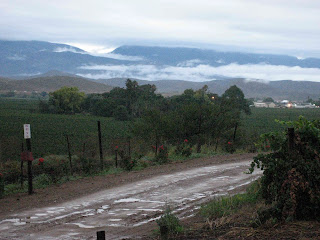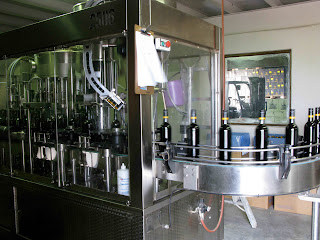My daughter Jenni, who lives in Canada, wrote to say she had been enjoying following our Vespa travels on the blog. She wanted to show it to a colleague at the school where she teaches, only to discover it had been censored by the Calgary Board of Education as being unsuitable for general access.
Their reason? Promotion of alcohol.
That's apparently very naughty in Canada.
Oh dear. I hope they don’t refuse me a visa next time I want to visit Canada.
Our journey is drawing to a close now. Yesterday we set off early on the trip to Darling, picking our way through the morning traffic until we emerged on the open road and could hum along happily at our usual cruising speed of 80km/h.
(Both scooters can go faster than that, but we find 80 about the most relaxing speed to travel.)
We skirted the young town of Atlantis, then past the old Moravian mission village of Mamre before approaching Darling between vineyard-covered mountain slopes.
The dirt road from the main road to Groote Post Estate is a very bad one. I know it from previous visits, so I asked Nick Pentz to fetch us from Darling, just a few kilometers away.
Bouncing over the rough track in his big 4x4 he agreed it wasn’t a nice place for a Vespa to be.
Groote Post is a peaceful and hospitable farm, set far from the bustle of main roads and busy commerce. The old white gabled homestead is now the venue for a delightful traditional restaurant called Hilda’s Kitchen.
A herd of nguni cattle grazes in he fields near the farmstead. There's a large private game reserve on the property and it includes an experiment in re-creating the officially extinct quagga.
Nick and winemaker Lukas Wentzel has set up a most interesting tasting of some of the farm’s older vintages and it was exciting to see how some of those white wines had lasted. The 2003 sauvignon blanc is still charming, showing a ripe richness that younger whites just can’t match.
I wish more people realized the delight of well-aged white wines.
Lukas has made a Methode Cap Classique rosé sparkler that has a dash of Merlot in the blend. It’s a deliciously smooth bubbly with a pretty copper colour and comfortably low acidity.
He says he plans to phase out the Merlot component over the next few vintages. Personally, I think this is a pity. Its inclusion makes it different from all the other MCCs on the South African market.
Ethene and I both enjoyed the two merlots we tasted. The ’03 is gently generous on the palate, offering ripe, soft fruit flavours.
The ’07 is still fresh, lively and crisp.
Pinot Noir is always an interesting grape variety, as it takes on the character of the soil it grows in. Groote Posts pinots are charming, with a hint of coffee on the 2006 vintage and a lovely cranberry character on the ’08. As I sipped it I couldn’t help thinking: “This is a happy wine.”
Lunch was a true country sosatie braai and salads, accompanied by too much of the good wine of Groote Post, then we were off to Darling for a cup of restoring coffee at the Marmalade Cat before hitting the road back to Cape Town.
We’ve covered about 1500km in all, without a single hint of trouble from the willing little 150cc motors.
We’ve stayed in cozy little farm cottages, luxurious country hotels and quite basic back-packer accommodation. We’ve met kind and interesting people all along the way and we’ve tasted many, many delicious wines and hardly any bad ones.
We owe many thanks to all those who have looked after us along the way and shared their homes, cellars and meals so generously with us.
In particular we’d like to thank our guardian angel, Jacqui Jones of Posy and Jeremy Hazell’s public relations team, for her organization of meetings, tastings and accommodation along the road.
We’ve probably given her a few grey hairs, but we’d have been lost without her guidance.
And if our ride has tempted anybody to try a long scooter trip, we have only one thing to say.
Go for it!
..




























